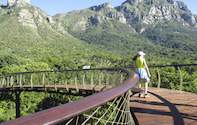
Endangered, Threatened, Rare, Restricted, Common and Wide-spread are some of the terms used to describe the status of species within a given area. The categories are defined in publications such as the 'Red Data Book'. The definitions are very often misused or misunderstood. They refer to numbers, viability and trends of species populations within a region.
Certain species that are declining because of predation and habitat destruction would be classified as 'Threatened'. Where numbers are very low - as 'Endangered'. Where populations have historically been very low due to environmental limitations they would be classified as 'Rare'.
Trends
Climatic fluctuations and habitat change may cause populations to move and numbers to vary over time. These periodic variations are a natural phenomena and one should not become unduly alarmed at the sudden absence of a species in a particular area. Quite often the management practices of 'park authorities' are blamed for destruction of a population, when in fact there has been a seasonal movement.
To properly monitor population trends, factors such as herd structure, condition, breeding success, survival rate, competition and predation must be taken into account. Early warning signs are found in sex ratios and survival rate. Limiting factors need to be noted and manipulated if possible. The actual numbers are not as important as observed viability and the extrapolation of graphically indicated long term trends.
Distribution
In the past, population management has often been too localised. Improved communications permit international assessment of species distribution. What was considered endangered within a certain region can often be classified as rare or marginal in relation to total population distribution. We have examples of sable, roan and certain other species of antelope. They are high succession grassland / savannah animals.
In early days they were not uncommon in the northern parts of South Africa but as fencing and cattle grazing eroded their habitat requirements so they became threatened. Habitat management could increase their numbers but they will never be a dominant species in this area.
They are at the southern limit of theircontinental distribution and a marginal species in this region. Their centre of distribution is in central Africa where numbers permit cropping for food. Marginal species are normally vulnerable to mismanagement. Many species now extinct were highly specialised and genetically or geographically marginal. Birds, plants and other categories should be similarly considered.
Trees
The central lowveld area is marginal for plant species from the south and from the north. Miombo woodland (Brachystegia sp.), which is widely distributed in central Africa, has a southerly limit in Venda and to the east in Mozambique. The 'Lowveld Chestnut'(Sterculia murex) is confined to the south in the Nelspruit area. Many of the Cape plants reach their northern limits in this area.
'Baobabs', are distributed, in various forms, in north western Australia, southern India and Madagascar. In Africa, they have a northerly limit south of the Sahara desert. Their natural, southerly limit is in the Hoedspruit areas, in the east and around Ellisras in the west. They are generally limited to the Tropics and to altitudes below 1000 metres.
Day length, temperature and rainfall are the probable limiting factors. There are a few individual trees south of Satara camp and protected, horticultural specimens down to Kirstenbosch gardens. It is not clear whether the baobab distribution in the Hoedspruit area is due to animal or human dispersal.
Many of the trees in our area produce good quantities of viable seed. Much of the cross pollination is carried out by fruit bats. Hoedspruit can be proud of the 'Glencoe Baobab' which has the greatest trunk diameter of any tree in South Africa.
The largest baobab (total of all other dimensions) is at Sagole, north of Tzaneen. The Limpopo Province has the first eight largest trees in South Africa - excluding the 'Wonderboom fig' in Pretoria. We have a lot of valuable natural resources - for which our provincial administrators should be encouraged to produce effective legislation and protection
Dave Rushworth

 While Stevenson-Hamilton believed in 'a balance of Nature', evidence suggests that the natural environment is never in a constant state of e...
While Stevenson-Hamilton believed in 'a balance of Nature', evidence suggests that the natural environment is never in a constant state of e...